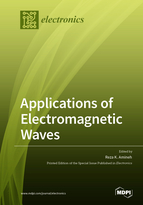Applications of Electromagnetic Waves
A special issue of Electronics (ISSN 2079-9292). This special issue belongs to the section "Microwave and Wireless Communications".
Deadline for manuscript submissions: closed (31 January 2020) | Viewed by 76243
Special Issue Editor
Interests: applied electromagnetics; antennas; microwave
Special Issues, Collections and Topics in MDPI journals
Special Issue Information
Dear Colleagues,
Harnessing the electromagnetic waves has created a revolution in engineering applications, with great impacts on various fields such as communication systems, industrial/biomedical sensing, remote sensing, radar, medical imaging and treatment, appliances, security screening, and so on. While some applications, such as communication systems and radar, can be considered more traditional, others, such as biomedical imaging and treatment, wireless power transfer, and security screening, are more recent and rapidly growing. This is in part due to the introduction of new concepts such as metamaterials, holographic processing, wireless power transfer methods, radio-frequency identification (RFID), and so on, which has resonated well with the rapid and significant progress in the field of RF electronics, leading to new commercial products. The objective of this Special Issue is to provide an overview of the current research on “Applications of Electromagnetic Waves”, highlighting the latest developments and innovations in modern applications, including, but not limited to, the following: communication systems, wireless power transfer, sensors, imaging, non-destructive testing, circuits, radar, antennas, micro-electromechanical systems, power generation and transmission, RFID, and so on. We will also try to identify new challenges and opportunities for new applications.
Dr. Reza K. AminehGuest Editor
Manuscript Submission Information
Manuscripts should be submitted online at www.mdpi.com by registering and logging in to this website. Once you are registered, click here to go to the submission form. Manuscripts can be submitted until the deadline. All submissions that pass pre-check are peer-reviewed. Accepted papers will be published continuously in the journal (as soon as accepted) and will be listed together on the special issue website. Research articles, review articles as well as short communications are invited. For planned papers, a title and short abstract (about 100 words) can be sent to the Editorial Office for announcement on this website.
Submitted manuscripts should not have been published previously, nor be under consideration for publication elsewhere (except conference proceedings papers). All manuscripts are thoroughly refereed through a single-blind peer-review process. A guide for authors and other relevant information for submission of manuscripts is available on the Instructions for Authors page. Electronics is an international peer-reviewed open access semimonthly journal published by MDPI.
Please visit the Instructions for Authors page before submitting a manuscript. The Article Processing Charge (APC) for publication in this open access journal is 2400 CHF (Swiss Francs). Submitted papers should be well formatted and use good English. Authors may use MDPI's English editing service prior to publication or during author revisions.
Keywords
- Imaging with electromagnetic waves
- Sensing with electromagnetic waves
- Electromagnetic applications in biomedicine
- Electromagnetic applications in nanotechnology
- Electromagnetic measurements
- Electromagnetic modeling of devices and circuits
- Inverse scattering and inverse electromagnetic problems
- Electromagnetic radiators and antennas
- Wireless power transfer based on electromagnetic waves
- Radio-frequency identification (RFID)






